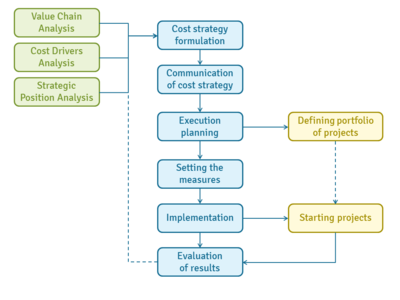Strategic cost management: Difference between revisions
(Infobox update) |
|||
| Line 27: | Line 27: | ||
* Cost Drivers Analysis | * Cost Drivers Analysis | ||
* Strategic Positioning Analysis<ref>Lisa M Ellram, Sue P Siferd, s. 57 - 60</ref> | * Strategic Positioning Analysis<ref>Lisa M Ellram, Sue P Siferd, s. 57 - 60</ref> | ||
[[File:strategic_cost_management_process.png|400px|right|thumb|Fig.1. Strategic cost management process]] | |||
== Value Chain Analysis == | == Value Chain Analysis == | ||
Revision as of 08:00, 8 September 2020
| Strategic cost management |
|---|
| See also |
Strategic cost management is a process connecting financial management, cost management and strategic management. It involves cost optimization and financial resources preparation which are needed to achieve desired strategic market position in cost effective manner. Strategic cost management involves identification and categorisation of most important cost for perform critical strategic projects and reduction of cost which are not important or less critical to achieve strategic objectives. From a strategic perspective cost management and financial resources management are very important task and responsibilities for the CEO of the enterprises.
Total Cost of Ownership as Strategy Cost Management
Total cost of Ownership (TCO) is a financial estimate and philosophy which is on purpose understanding actual cost of purchasing a specific good or service from a specific supplier. It also helps buyers and owners establish direct and indirect cost of a product or system. This analysis meant to uncover all the lifetime costs that follow from owning certain kinds of assets.
Total Cost of Ownership is real when is on strategic standard as support the organization operation. Analysis TCO can be qualified as strategic cost management, if the organization take into account both internal and external costs. All Analysis help strategic cost management thanks to the wide impact of decisions purchasing for organization costs. Relationship Total Cost of Ownership and Strategic cost management is contained in three different types of techniques:
- Value Chain Analysis
- Cost Drivers Analysis
- Strategic Positioning Analysis[1]
Value Chain Analysis
Value Chain Analysis is a strategic tool used to analyze internal activities company. The goal of the company is internal activities is to determine which activities are the most valuable for the company and which can be improved to provide an advantage over the companies. This concept was first described by Michael Porter. He suggested that all activities should be at an optimal level if the organization is to gain a real competitive advantage. Companies conduct a value chain analysis, analyzing each production step required to create a product and identifying ways to improve the performance of the chain. The Value Chain analysis tends to the maximum value at the lowest total cost and creation of a competitive advantage.
Cost Drivers Analysis
Cost Driver Analysis requires understanding what causes costs. Analysis of driver costs is the study and explanation of the effects of cost factors. The purpose of the cost analysis is to search for the underlying causes of operating costs.The cost driver for short term indirect variable costs may be the volume of output or activity. In case of long term indirect variable costs, the cost drivers will not be related to volume of output or activity.
Strategic Positioning Analysis
Strategic Positioning Analysis is an approach for researching what future environments might be like in your internal corporate structure as well as your external environment and determining how you can use the choice of business strategies to get from your current situation to these desirable goals. Strategic positioning is translate in two things: lower cost for the company or offer the best products.Driving down costs is way to increase profitability. To compete on cost, companies must balance price with acceptable quality (cost leadership). Driving up prices also increase profitability. The company must deliver distinctive value to customers to achieve higher price (Product Differentation). [2]
Stages of Strategic Cost Management
- Formulating Strategies
- Communication of Strategies in the entire organization.
- Planning and improving tactics, to execute those strategies.
- Developing and realizing controls to track the success.
Implementation of strategies involves all those means related to executing the strategic plans. It is managing forces during the action which requires coordination among many individuals.It is mainly an Administrative Task based on strategic and operational decisions which emphasizes on efficiency. Implementation of strategy is the translation of chosen strategy into organizational action so as to achieve strategic goals and objectives.
Implementation of strategies is defined as the manner in which an organization should develop, use, and connects organizational structure, control systems, and culture to follow strategies that lead to competitive advantage and a better performance. Organizational structure allocates special value developing tasks and roles to the employees and states how these tasks and roles can be synchronized to maximize efficiency, quality, and customer satisfaction.[3]
References
- Anderson, S. W., & Dekker, H. C. (2009). Strategic cost management in supply chains, part 2: Executional cost management. Accounting Horizons, 23(3), 289-305.
- Lisa M Ellram; Sue P Sifer (1998)Total Cost of Ownership: a key concept in strategic cost management decisions Journal of Business Logistic, 55-84
- Vijay Govindarajan and John K. Shank (1992)Strategic Cost Management: Tailoring Controls to Strategies Journal of Cost Management, L3-1 - L3-11
- John K. Shank, Dartmouth College (1989) Strategic cost management: The new tool for strategic management Journal of Management Accounting Research Volume One, 47-65.
Footnotes
Author: Weronika Góra
